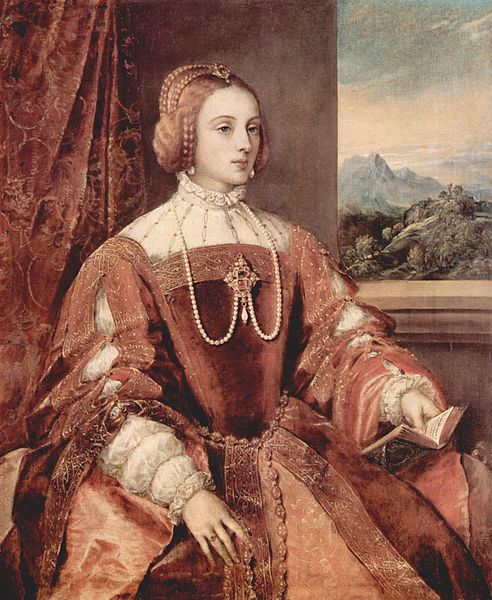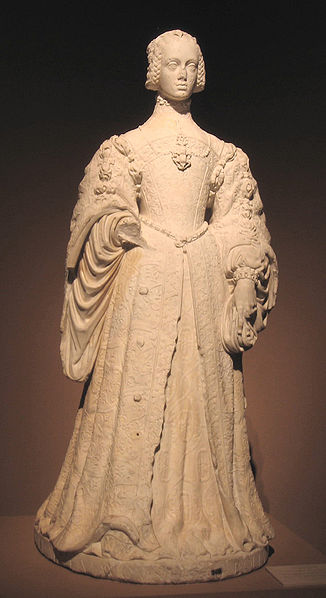<Back to Index>
- Chemist Hendrik Willem Bakhuis Roozeboom, 1854
- Writer Sarah Josepha Buell Hale, 1788
- Holy Roman Empress Isabella of Portugal, 1503
PAGE SPONSOR


Isabella of Portugal (24 October 1503 – 1 May 1539) was a Portuguese Princess (Infanta) and Holy Roman Empress, Duchess of Burgundy, and a Queen Regent / Consort of Spain. She was the daughter of Manuel I of Portugal and Maria of Aragon. By her marriage to Charles V, Holy Roman Emperor, Isabella was also Holy Roman Empress and Queen consort of Aragon and Castile. She served as the regent of Spain during the absence of her spouse for long periods.
Isabella was the second child and eldest daughter of Manuel I of Portugal and his second spouse, Infanta Maria of Castile and Aragon. She was named after her maternal grandmother, Isabella I of Castile and her aunt Isabella, Princess of Asturias, who had been her father's first spouse.
Through her father, she was a granddaughter of Infante Ferdinand, Duke of Viseu (the second son of king Edward of Portugal and brother of Afonso V of Portugal) and Infanta Beatrice, the daughter of Infante João, Lord of Reguengos (brother of king Edward). Through her mother she was a granddaughter of Isabella I of Castile and Ferdinand II of Aragon.
Isabella was second - in - line to the throne until the birth of her brother Louis in 1505. However, as the oldest daughter of Manuel I of Portugal, she was a rather attractive party. She married her first cousin, Charles V, Holy Roman Emperor, the son of Joanna of Castile and Philip the Handsome, Duke of Burgundy, who as Holy Roman Emperor, King of Aragon and Castile, Archduke of the Habsburg dominions, titular Duke of Burgundy, and ruler of the Netherlands and the Spanish empire in the Americas and the Mediterranean and Italy was one of the most powerful men of his time.
In 1521 Isabella's father died and her brother succeeded to the throne as king John III.
The marriage negotiations between the Portuguese and Spanish began
almost immediately. It was agreed that the new king would marry Catherine of Austria,
Charles V's younger sister. The union between Charles and Isabel only
took place three years later, by procuration in 1525. The Infanta
travelled to Seville where
the wedding took place on 11 March 1526. With Isabel also came a huge
dowry to the Spanish finances. Although it was a political union, the
marriage proved to be a love match. Records say that during their
honeymoon "when [Charles and Isabel] are
together, although there are many people around, they do not notice
anyone else; they talk and laugh, and nothing else distracts them."
Isabella also proved to be a competent consort; she served as regent of Spain during her husband's absences, between 1529 – 1532 and 1535 – 1539. She was noted for her intelligence and beauty.
Isabella died in 1539 after the birth of her seventh child. The Emperor was away at the time and her premature death affected him deeply. He never remarried, and he dressed in black for the rest of his life.
In 1547, the nobleman Francis Borgia conveyed her corpse to her burial - place in Granada. It is said that, when he saw the effect of death on the beautiful empress, he decided to "never again serve a mortal master", later becoming a Catholic saint.
In 1580, more than 40 years after her death, her son Philip succeeded the Portuguese throne, claiming his mother's successory rights.
Isabella married Charles V, Holy Roman Emperor on 10 March 1526. Their children were:
- Philip II of Spain (1527 – 1598), King of Spain and Portugal.
- John of Spain (22 March 1528 – 1530) Died Young.
- Maria of Spain (21 June 1529 – 26 February 1603), married her cousin Maximilian II, Holy Roman Emperor.
- Ferdinand of Spain (19 October 1535 – 20 March 1538) Died Young.
- Joan of Spain (1537 – 1573), married her cousin Prince John of Portugal and was the mother of king Sebastian of Portugal.
- John (30 April 1539) His Birth caused the death of his mother.